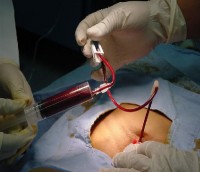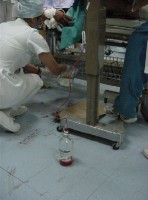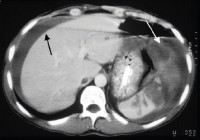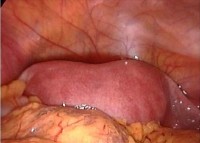The following pictures are from different clinical cases.
In Blunt Trauma the spleen and the liver are injuried in 40 and 20 percent, respectively.
In the ER, you have three four options in the Work-Up of a patient with blunt abdominal trauma
- Peritoneal Lavage: Now just performed if you haven’t access to ultrasound (lack of money or lack of trained personnel). It’s indicated in specific cases, as in patients with cranial trauma, spinal trauma, for example.
- Ultrasound (a.k.a. FAST or Focused Abdominal Ultrasound for Trauma): This is one of the most used techniques, and should be performed for those patients hemodynamically unstables who can’t go to the coputed tomography room.
- Computed Tomography: This technique has a magnific resolution for spleen, liver and vessels. Excellent evaluation for retroperitoneum. It has one inconvenience, hemodinamically unstable patients are not candidates for this analysis.
- Diagnostic Laparoscopy: Almost never recquired.
The controversy is when the hospital is not capable of performing the standarized protocol in blunt abdominal trauma (economic reasons), we doctors have to adequate to the circumstances and do our best effort.
For example, the first two photographs (peritoneal lavage) were taken at the Mexican Red Cross where money is the big problem. The rest, were taken at the ABC Medical Center, a nice private hospital. This are the contrasts of healthcare system and medicine practice in developing countries.
Regards,
Dr. Jon Mikel Iñarritu





Pooya Iranpour,
Children have more physiologic reserve, when they are hemodynamically unstable they are really ill. Why don’t you read the chapter of Trauma in Children in the ATLS manual? There is also a chapter of this in the textbook Trauma by Mattox and Feliciano.
Hello, I am a medical student trying to understand why splenic injuries heal faster in children than in adults. Hemodynamic instability does not occur as much in children as it does in adults (after splenic injury/rupture). Can you suggest literature to read or do you have any theories as to why this is the case.
Thank you.
Jon:
In splenic injuries you can divide its treatment in two major groups:
1. Operative treatment
2. Non-operative treatment.
Just in the Non-operative management cases of spleen bleeding (or hepatic bleeding), you could use the benefits of the angioembolization (like Gelfoam) in order to gain time.
The primary requirement for nonoperative treatment is hemodynamic stability.
The complications (missed abdominal injuries, parenchymal infarction, infection, aseptic infarcts, infected hematomas, etc.) of nonoperative therapy for blunt splenic and hepatic injuries, occur in 2% to 5% of patients.
In fact, the presence of ischemia, hematoma, and/or tissue injury secondary to trauma could increase the risk of secondary infection in the use of transcatheter gelfoam embolization.
As you say, nonoperative measures are usefull just in minor trauma.
Thanks for your comment.
I was once consulted as a case manager regarding a liver biopsey that would not stop bleeding. CT was down. I thought gelfoam which is what they did. Epo and progesterone was also discussed.
In the case of third world medicine (where I sometime lecture and work) and it’s limitations, would epo and progesterone which works in GI bleeds also work for minor liver trauma as well. This to buy time to stablize.